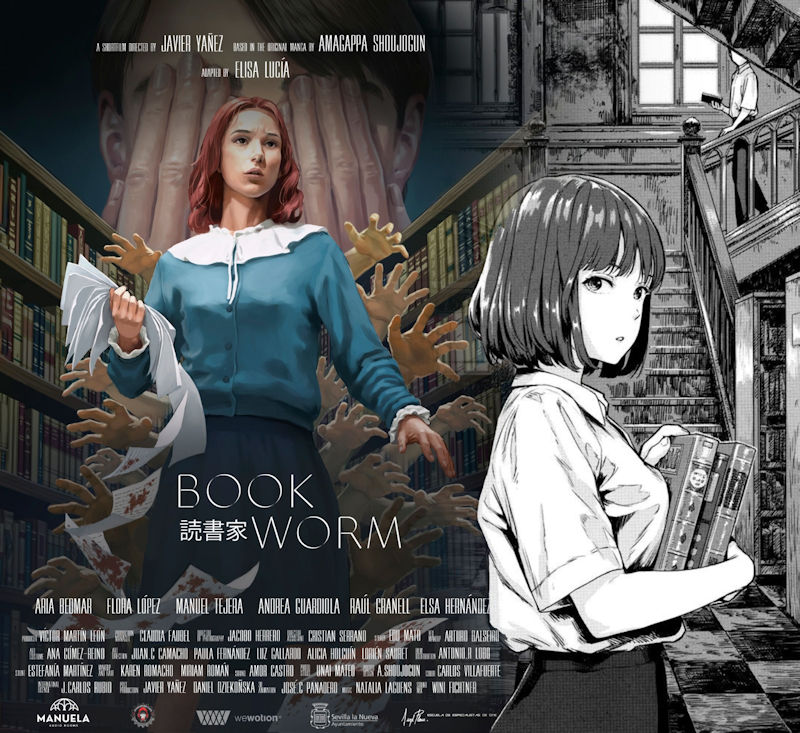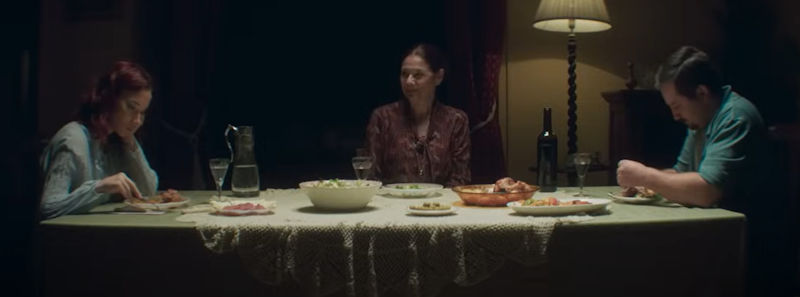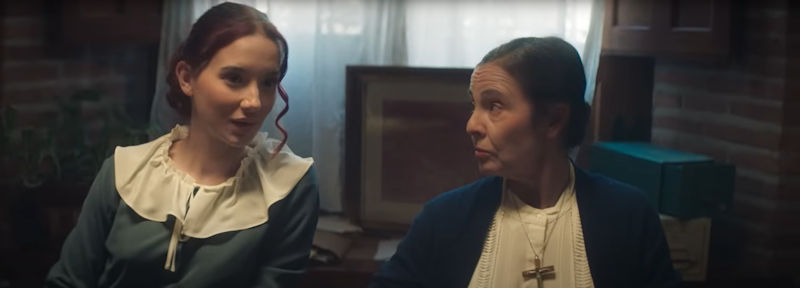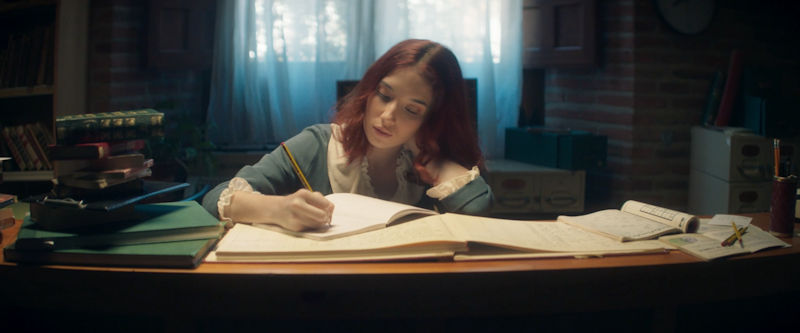
Written by Richard Durrance on 10 Dec 2024
We’d like to welcome to the UK Anime Network offices (plush Mayfair abode, honest, not really just a construct of my fevered imagination) Javier Yañez, director of the award-winning Bookworm, a short film based on a one-shot manga by Amagappa Shoujogun that was included in an horror anthology of, Dead Angle, compiled by manga legend Junji Ito.
Before going any further I’d suggest, if not already, to check out the Bookworm short film on Youtube, as otherwise you may find spoilers ahead.

I’d like to start with asking how you set about adapting the manga? Especially considering it could be very easy to use a manga as a storyboard and go almost shot for shot. Instead you have created a lot of original content alongside some that is very faithful. Also how did you decide when to deviate and when to remain close to the source material?
I believe manga and cinema share some aspects, but they also differ significantly. We made changes in two main ways:
First, we gave the script a structure that allowed us to learn more about the characters and their motivations while keeping the audience engaged. I think Elisa Lucía, the screenwriter, did an excellent job in this regard.
Then, we tried to adapt their decisions to make them coherent. The original manga is set in Japan, where arranged marriages can still occur, but this didn’t make sense in Spain. So, we decided to set the story in the past when such practices were more plausible.
Lastly, I always rely on music to draw my storyboards. I created them without referencing the manga to give it my perspective. However, I later revisited the manga and replaced some frames with those I felt were superior in the original work as a tribute to the source material.

An uncomfortable dinner with Irene, her mother and her potential suitor.
I was very struck with the scene where the potential husband arrives for dinner and his eating habits. It brought to mind Leone’s opening to Duck You Sucker (aka A Fistful of Dynamite), where the “how” of eating is shorthand to describe a character. Especially in a short film where you have limited time to setup character and narrative, how important is this type of cinematic shorthand, and are there any you are particularly proud of?
In this case, the scene establishes a parallel between the ghost's hands, which are the only thing the protagonist saw and fell in love with, and the hands of the suitor her mother chose for her. And yes, how he eats defines his character.
I thought it would be interesting to show him eating something with his hands because it could appear rather disgusting, contrasting with the ghost’s beautiful hands. Recently, I watched the film The Substance, and I noticed the director used a similar scene. I think this technique works well and helps position the characters quickly for the audience.
Though the synopsis places the story in 1979, which I only read after watching the film, if anything the film felt very timeless. How important is it to both embed the film in a particular milieu versus creating timeless stories and themes?
The decision was made to make the plot logical. In today’s world, parents can only decide or force you to marry someone in certain countries, but not in Spain. We needed to set the story in Spain, so we placed it in a time when this could have been plausible.

Irene with elder librarian Counsuelo
The elder librarian, Consuelo, reading her pornographic literature, made me think she would want to be sneaking out to be watching a Walerian Borowczyk film, while at the same time her strait-laced image despite her reading matter made me think she could easily appear in a Pedro Almodovar movie. I’d be interested in what made you change this aspect of the character?
The idea was to show her being impressed by what Irene was writing to contrast a stricter, religious personality with a younger person who is more inquisitive.
This is not the first short-film based on a manga, can you describe what it is that appeals to you about adapting any particular work?
I love horror manga. It has always been a source of inspiration for me. Japanese authors often portray characters as morally gray rather than purely good or evil, which I find fascinating. I’m not interested in stories where the “good guy” always triumphs over the “bad guy.”
You seem to use a mixture of dream-like, warm, and often very precise close up, then cut to some very crisp deep focus. Were there are particular cinematic techniques that you were aiming to employ when filming particular scenes?
All those shots were filmed by me with my camera since we had very little time to shoot. I used lighting and set changes to create those visuals.
I used a vintage anamorphic lens called the Iscorama Pre36, paired with a 50mm lens with a very high aperture of 2.0.
There is a lot of eroticism and intimacy in the film, the turning of the pages, something that will pay off in the ending, for instance, and even arguably though revolting, the eating of the chicken, though again this arguably plays into the ending – and the moments of Irene reading - how do you go about generating a specific tone for these moments?
I usually imagine sequences while listening to music, which helps me find the tone. I believe everything has its rhythm, and it’s essential to discover it. In this case, it was challenging, no doubt about it. Exploring the realm of romantic sadism is difficult, and I had to trust my instincts to achieve the right tone.
As the music is integral to the tone of the film, how did you go about having it scored? Is this something that you are involved in, or trust the composer?
I choose similar tracks to what I envision and edit the film using them. Then, a composer creates original pieces from scratch, refining the tone and improving upon the initial choices.
In this case, I was fortunate that Natalia Lagens, the composer, loved the story and created a central theme before we even started shooting. This theme, tied to the protagonist’s feelings for the ghost, was even used during filming, but this is not the usual process.
Religion and tradition play a large part in the film, even if apparently in passing, and one assumes on Aria Bedmar’s character of Irene – though picking up aspects of the manga, how important was it to you embed it the story in Spanish culture of the time, and also of today?
As I mentioned earlier, the decision was made to justify why the mother could arrange a marriage for her daughter.
We needed Irene to face a future she didn’t want to idealize the ghost as an escape mechanism from her reality. 😊

Aria Bedmar as Irene
Aria Bedmar’s Irene passes through numerous emotional states, from the almost passive aggressive ignoration of her mother’s heckling, to romantic dreaming. How did you go about working with Aria on her performance?
We rehearsed for a couple of days before filming, which allowed us to refine all these aspects.
For instance, we decided that Irene had been a very protected child, cared for by her late father. After his death, her mother became obsessed with controlling her life to ensure she had a good future, even using her father’s memory to manipulate her. You can see this dynamic in the scene where Irene ignores her mother while she’s sewing.
Returning to the erotic, the intimate and also to how these intersect with horror, the ending had echoes of the dreamlike romanticism of Candyman and the more brutal erotic flaying of Hellraiser. Though the scene is similar to the manga, did you feel yourself influenced at all by films of the past?
No, I only used the manga as a reference, but many people have mentioned this similarity. I haven’t seen Candyman though I did watch Hellraiser more than 20 years ago.
I’m not someone who actively seeks cinematic references for my projects, but I’m often told my work resembles well-known films. While I find this flattering, it’s not something I aim for intentionally.
Sometimes our influences can be far-flung from what we create, what inspires you as a consumer of culture and as a film-maker?
Manga is my primary inspiration. I do watch films that inspire me, but honestly, I read more manga than anything else.
Assuming you had an unlimited budget and control, assuming you’d even want that, what would you film next?
I have a feature film in development, though I’m unsure if I’ll need to self-finance it since finding producers is no easy task. I also have several short films in progress, some involving negotiations for rights and others based on original ideas. I love these projects, with or without funding.
But if you’re asking about a dream project with a massive budget, I’d love to create a live-action adaptation of Evangelion or Nausicaa.
Both in the general sense and in adapting Bookworm, what do you see are the strengths and weaknesses of short film-making? Were there any themes or parts of the film that you would have liked to expand upon given the chance?
The biggest challenge in short filmmaking is money and time. You have very little time to shoot, and many things can go wrong because the crew isn’t being paid and might drop out. This forces you to be highly creative, not just artistically but also in organizing the process. You must adapt to unexpected issues while maintaining a positive attitude.
It’s tough, but I think it’s excellent training for directing a feature film. I’ve made seven shorts so far, and despite the challenges, I enjoyed this one without feeling too nervous.
It would’ve been nice to expand Irene’s ending beyond what’s shown in the short and the manga. Perhaps a scene where she replaces the spirit as the library’s reader, and a boy discovers her and picks up what she was reading. That would’ve been beautiful, but we didn’t have the time or budget to film anything extra.
Our profound thanks to Javier Yañez Sanz for his time and willingness to discuss Bookworm with us.If you'd like to keep up with his future projects, give him a follow over on X - @sanz_yanez

Long-time anime dilettante and general lover of cinema. Obsessive re-watcher of 'stuff'. Has issues with dubs. Will go off on tangents about other things that no one else cares about but is sadly passionate about. (Also, parentheses come as standard.) Looks curiously like Jo Shishido, hamster cheeks and all.
posted by Ross Liversidge on 27 Nov 2025
posted by Ross Liversidge on 21 Nov 2025
posted by Ross Liversidge on 16 Oct 2025
posted by Ross Liversidge on 14 Oct 2025
posted by Ross Liversidge on 10 Oct 2025
posted by Ross Liversidge on 30 Sep 2025
posted by on 12 Sep 2025